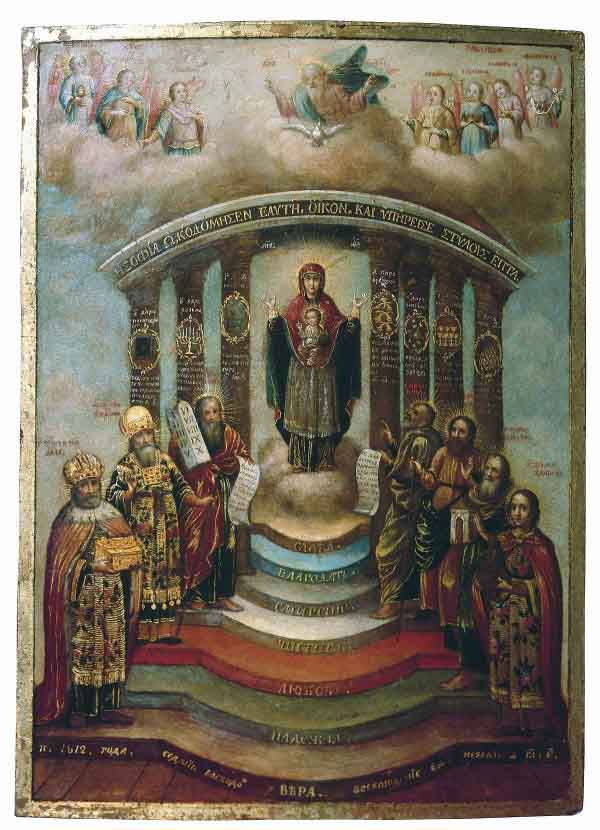
The influence of classical Greek thought was present in most aspects of intellectual life in the middle ages. Aristotelian thought is central to the works of Thomas Aquinas, perhaps the best known theologian of the era and neoplatonism was influential on those theologians of a more mystical inclination. In the musical world, the basis of medieval music theory – the Church modes – was derived directly from the medieval understanding of Greek musical theory. This musical theory had its origins in the Pythagorean school. Pythagoras was the first westerner to record the mathematical relationships between pitches and used these relationships to derive musical modes. Related to this was the idea, also attributed to Pythagoras, of the music of the spheres, the concept that the proportions of the movements of celestial bodies create an inaudible music that is superior to any form of audible music. Implied in this idea is the belief that audible music should microcosmically re-create this celestial music.
Medieval music theorists did not interpret this Pythagorean conception of music as a mere metaphor. There existed a consensus that certain musical intervals were superior to others by virtue of their simpler and therefore more universal harmonic ratios. As a result the earliest examples of organum in medieval music involved the doubling of a chant melody at a consonant interval (1). Over time this practice evolved organically, with the added voice being granted greater independence from the original melody. Eventually organum evolved into a practice where the notes of the chant melody were extended into lengthy drones while the added voice sung extended composed melismas. This practice was known as florid organum.
This example shows an earlier form of organum with the added voice having some independence, however parallel consonsances still form a significant component of the musical texture.
This next example comes from the St. Martial of Limoges school of composition which produced a large number of works in the 12th century. This piece is not based on a chant melody and is therefore not an organum but rather a conductus. This shows the trend towards more freely composed music.
By the latter part of the 12th century the practice of organum was widespead across Europe and numerous theoretical treatises had been produced which shed light on the musical thought of the time. One of these treatises came from an English music student studying in Notre-Dame, Paris, who is known only as Anonymous IV. He wrote at length about the two musical masters working out of Notre-Dame whom he called Leonin and Perotin. If not for Anonymous IV’s treatise the names of these composers would not be known. Together these composers made a number of significant innovations in the composition of organum and other genres which ushered in a new era of musical composition and played a key role in the eventual development of counterpoint and harmony.
The older of the two composers of the Notre-Dame school, Leonin, is best known for his organum duplum (organum with one voice added to a chant melody) which employ a form of rhythmic organisation using six rhythmic modes (short rhythmic patterns). Leonin’s younger contemporary, Perotin, was probably the earliest composer to add a third and fourth voice in his organum. He was therefore instrumental in the development of counterpoint of which his music is an early example albeit following different rules to those that governed the counterpoint of later composers. Perotin also utilised the six rhythmic modes although in contrast to Leonin’s free and improvisatory use of these modes Perotin created thematic structures from these rhythmic materials which were developed and varied throughout a piece. Through the use of this and other techniques Perotin composed organum which were an early example of large scale, structured compositions of the kind which became the standard during the common practice period.
This example is a somewhat stylised performance of an organum composed by Leonin. The use of rhythmic modes and melismas above a chant melody are made quite clear.
https://www.youtube.com/watch?v=gtkmnhnHWhw
And here we have one of Perotin’s two surviving organum quadruplum: Sederunt Principes.
[1] It may be of interest to note here that this doubling of a melody at a consonant interval is precisely the same technique as playing a melody in power chords rather than single notes since the melodic line is doubled at the fifth.
13 CommentsTags: Aristoteles, Church modes, Early Music for Metalheads, florid organum, music of the spheres, neoplatonism, Organum, Pythagoras, Thomas Aquinas, Tom Devereux


